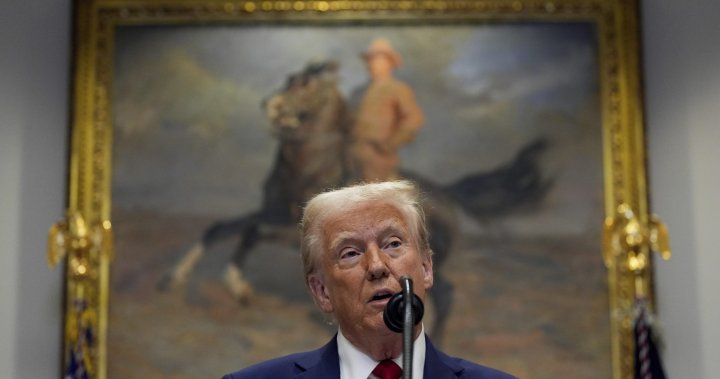U.S. President Donald Trump on Tuesday denied that his threat of sweeping tariffs on goods from Canada and Mexico is meant to force early trade renegotiations, insisting he’s responding to “massive” flows of fentanyl and migrants into the U.S.
The Wall Street Journal reported that Trump’s tactic was meant to kickstart talks on the Canada-United States-Mexico Agreement (CUSMA), which replaced NAFTA during Trump’s first term as president, before it comes up for review in 2026. The report cited people familiar with Trump’s thinking.
Asked about the report during an unrelated press conference at the White House, Trump said his threat of 25 per cent tariffs against Canada and Mexico, which he said will “probably” begin on Feb. 1, has “nothing to do with” CUSMA.
“They’ve allowed — both of them, and Canada very much so — they’ve allowed millions and millions of people to come into our country that shouldn’t be here,” he said. “They could have stopped them and they didn’t.
“The fentanyl coming through Canada is massive. The fentanyl coming through Mexico is massive. And people are getting killed and families are being destroyed.”
Trump also said said his administration is discussing imposing a 10 per cent tariff on goods imported from China on Feb. 1 “based on the fact that they’re sending fentanyl to Mexico and Canada.”

Trump has previously said he wants to reopen CUSMA when it comes up for review to close loopholes that Canadian and U.S. officials say are being exploited by China to enter the North American auto market through Mexico.

Get daily National news
Get the day’s top news, political, economic, and current affairs headlines, delivered to your inbox once a day.
The president signed a sweeping executive order on trade policy Monday that included a direction to the U.S. trade representative to commence public consultations “in preparation” for CUSMA’s scheduled 2026 review, assess the trade agreement’s impact on American workers and agricultural producers, “and make recommendations regarding the United States’ participation in the agreement.” The order set an April 1 deadline for that report and other trade policy reviews.
Trump has long tied his tariff threat to concerns about human and drug smuggling into the U.S. from Canada and Mexico.
Ottawa has sought to respond to those issues with a border security plan it detailed last week, but Trump has continued to repeat his claims. He called Canada “a very bad abuser” of the U.S. border shortly after his inauguration Monday.
Speaking outside the Liberal cabinet retreat in Quebec earlier Tuesday, Ambassador Kirsten Hillman, Canada’s envoy to the U.S., pushed back on Trump’s rhetoric.
“Those are not words that Canada would use in speaking about our closest friend and ally,” she told reporters.
“When it comes to our border, Canadians know the facts: there is no criminal trafficking of fentanyl to the United States from Canada, we represent less than one per cent of any illegal crossings.”
U.S. Customs and Border Protection said it seized more than 5,000 kg of illegal drugs at the Canadian border during the last fiscal year between October 2023 and September 2024. That included 19.5 kg of fentanyl — a more than 200-per cent increase from two years prior.
That number pales compared to the 9,570 kg of fentanyl seized at the U.S.-Mexico border during the same time period, which also saw 316 kg seized at coastal and interior checkpoints in southern states.
According to the U.S. Drug Enforcement Agency, two milligrams of fentanyl is a potentially fatal dose.
Migrant encounters at the northern border, meanwhile, totaled 23,731 people in the last fiscal year, more than double the year before, although the number of monthly encounters has been declining sharply since last June. Over 1.5 million migrants were encountered at the southern border last year.

During Tuesday’s press conference, Trump made several references to tariffing other U.S. allies and trading partners like the European Union. He has often claimed tariffs will raise government revenues that will be used to lower costs for Americans, despite economists saying prices on tariffed goods will rise for U.S. consumers, and will also correct trade deficits.
“It’s the only way you’re going to get fairness,” he said. “You can’t get fairness unless you do that.”
Trump also repeated his assertions, which experts call “preposterous,” that California can “turn the valve” and bring in water that flows from Canada into the Pacific Northwest. Water management experts have said the infrastructure does not exist for that.
“They have all this water, and it’s really good water up high in the Pacific Northwest,” Trump said. “Some comes in from Canada — nice country, by the way.”
Trump said he’ll issue an executive order “demanding that they immediately let that water come down through to California farmers, even people living in Beverly Hills.”
Hillman said the border is just “one of the core issues” Trump is focused on, alongside economic “fairness” and “energy dominance,” which Canada wants to work with the U.S. on achieving.
“It is a border that has two sides,” she said. “We also have things that we want to talk to them about, about how we manage our border. That is where we need to be paying attention.”
Prime Minister Justin Trudeau said earlier Tuesday he is in favour of imposing “matching” retaliatory tariffs if Trump follows through with his tariff threat.
“I support the principle of dollar-for-dollar matching tariffs. It’s something that we are absolutely going to be looking at if that is how they move forward,” he told reporters outside the cabinet retreat.
—with files from Global’s Saba Aziz
© 2025 Global News, a division of Corus Entertainment Inc.




